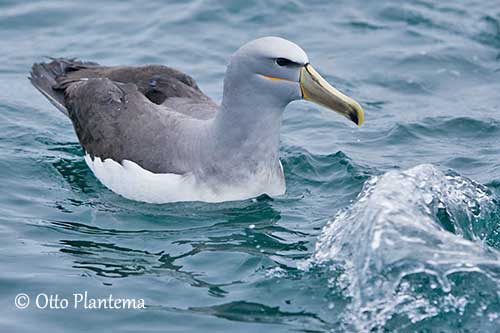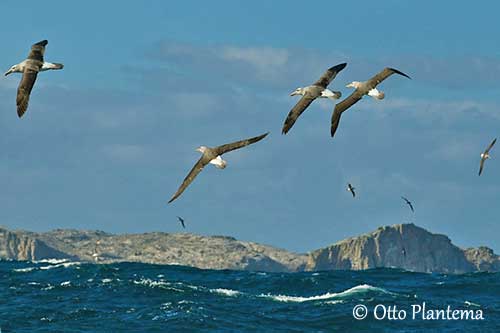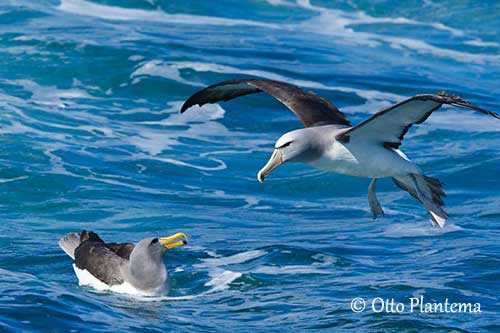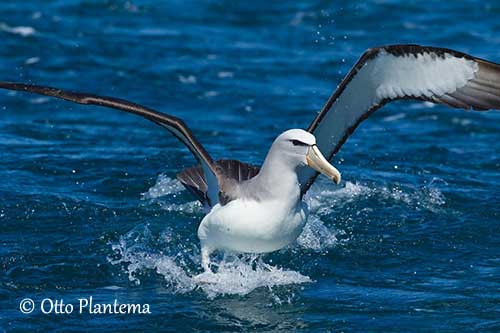
Fr: Albatros de Salvin
Ang: Salvin’s Albatross
All: Salvinalbatros
Esp: Albatros de Salvin
Ita: Albatros di Salvin
Nd: Salvins Albatros
Sd: salvinalbatross
Photographer:
Otto Plantema
Trips around the world
Text by Nicole Bouglouan
Sources:
HANDBOOK OF THE BIRDS OF THE WORLD vol 1 by Josep del Hoyo-Andrew Elliot-Jordi Sargatal - Lynx Edicions - ISBN: 8487334105
A Complete Guide to Antarctic Wildlife by Hadoram Shirihai and Illustrated by Brett Jarrett - Edited by Guy M. Kirwan - ALUL.A Press Oy, Finland - ISBN 9519894705
Department of Sustainability, Environment, Water, Population and Communities
Wikipedia, the free encyclopaedia
Salvin’s Albatross
Thalassarche salvini
Procellariiformes Order – Diomedeidae Family
INTRODUCTION:
The Salvin’s Albatross was formerly a subspecies of the Shy Albatross (T. cauta) from which it differs by some morphological features. It is a typical medium-sized albatross ranging across the Southern Ocean. It breeds on small rocky islands in dense colonies, but outside the breeding season, it often occurs at sea over the continental shelf.
The name of this species pays tribute to the English ornithologist Osbert Salvin (1835-1898).

DESCRIPTION OF THE BIRD:
Biometrics:
Length: 90-100 cm
Weight: M: 3300-4900 g – F: 3300-3700 g
The Salvin’s Albatross adult is a medium-sized albatross. On the upperparts, the upper mantle is grey. Back, upperwing and tail are blackish-grey but the rump is white.
Chin and throat are grey whereas underparts and underwing are white, contrasting with narrow, black leading and trailing edges and wingtips.
Head and face are silver grey.
The bill is pale greyish-green with pale yellow culmen and lower mandible, dark spot at tip of lower mandible and elongated bright yellow patch at lower base. The eyes are dark brown, surrounded by narrow, white eyering. Legs and webbed feet are pale pink.
Male and female are similar, but the male is larger overall.
The juvenile has olive-brown bill with dark tip, grey areas are more extensive especially on head and neck, and its plumage is paler and duller than in adults.
RANGE:
The Salvin’s Albatross occurs in S Indian and S Pacific Oceans. It breeds on several islands including Crozet, Snares and Bounty Islands. After breeding, it disperses in Southern Ocean W to SW Indian Ocean and E to W South America where it is commonly seen off C Chile. It is vagrant in S Atlantic Ocean.
HABITAT:
During the breeding season, the Salvin’s Albatross can be seen in colonies on offshore rocky islands, nesting on barren slopes or flatter areas, gently sloping ledges, summits and caves, generally in broken terrain with little soil and vegetation. Outside the breeding season, it occurs at sea, over the continental shelf.

CALLS AND SONGS: SOUNDS BY XENO-CANTO
The Salvin’s Albatross is usually silent at sea, but while foraging, it produces harsh croaking during squabbles. They generally utter a variety of brays, croaks and wails during the courtship displays.
BEHAVIOUR IN THE WILD:
The Salvin’s Albatross feeds primarily on fish, squid, krill and Salpidae. Offal from fishing vessels is taken from the surface.
It rarely plunges or dives for preys. It feeds by surface-seizing and scavenging. The breeding adults remain close to their colonies and forage over the continental shelf.

During the breeding season, and especially at the beginning, the pair defends the nest-site with bill-snapping at intruders, and violent fights may occur.
They are monogamous with long-term pair-bonds. The repertoire of courtship displays is very ample, with long sequences of stereotyped postures, usually repeated continuously. The usual displays include bill-circling, sky-pointing, flank-touching with the bill and wing-spreading, often accompanied by various calls while the birds are facing each other.
The Salvin’s Albatross is a colonial nester and the adults return to their breeding colonies in September.
The post-breeding migration leads the birds to seas off Peru and Chile, and they wander in the South Atlantic Ocean.
The Salvin’s Albatross is an excellent flier like all the Diomedeidae. However, take-off is always difficult, and rapid manoeuvres are not easy in flight. Landing at breeding grounds is one of the most difficult exercises, and collisions with various obstacles and even humans are not uncommon.
But with such large wingspan, albatrosses usually glide along, rising and falling, taking advantage of the varying speeds at different heights.

REPRODUCTION OF THIS SPECIES:
The Salvin’s Albatross is an annual breeder and usually returns to the same nest-site every year. They breed in large, dense colonies with one nest per 1,9 m². The egg-laying occurs in early October, and the hatching begins in early to mid-November.
The nest is a truncated cone with a central depression. It is made with mud, guano, feathers and some bird bones. The cone is low, between 85 and 155 millimetres tall according to the slope.
The female lays a single white egg with reddish-brown spots at broader end. Both adults incubate during 68-75 days. At hatching, the chick has white down, black bill and eyes, and pale pink legs and feet. It is fed by both parents and fledges about 115-130 days after hatching. It is independent at fledging.
PROTECTION / THREATS / STATUS:
The Salvin’s Albatross is vulnerable to extreme weather events and slow ocean warming, both involving changes in availability of food resources. At sea, the longline fishing may be a significant threat, but not the most important. This species has restricted breeding range on small rocky islands.
The global population is estimated at 61,500 mature individuals, or roughly 90,000 individuals. The Bounty Islands’ population represents 99% of the global population, and no introduced predators are present on these islands.
But currently, the Salvin’s Albatross is classified as Vulnerable.